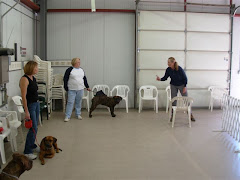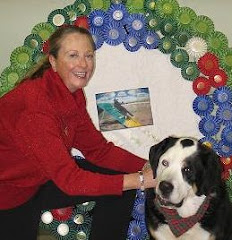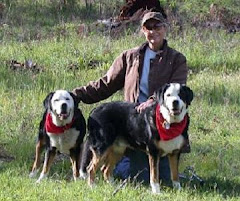"She sweet, but stubborn and bull-headed," Erika said of her pit bull/border collie rescue. "And she's a drama queen."
Sadie did cause drama in dog class. Every time Erika tried to encourage and then enforce a behavior, Sadie would scream bloody murder, causing Erika to back off on her request. Sadie was only mildly interested in food and toys, so those ploys didn't work to motivate her. Yet every once in a while she'd catch fire and do precisely what Erika requested, with a happy face and pizazz to spare.
I asked Erika to bring Sadie over and leave her with me for an afternoon so I could try to figure out what Sadie's "problem" was.
The first thing I did was fit her with a training collar (choke chain). Erika had been using a static buckle collar in class, and Sadie had learned to just sit down on her haunches and pull against it when she didn't want to do something. The choke chain is a dynamic tool that gets the dog's attention and then instantly rewards them for making the right choice. A "zip-zip" with the choke chain persuades the dog to move toward you, rather than away from you. As the dog moves in the right direction, the leash and collar immediately go still and slack, thus convincing the dog he's making the right choice. You, at the other end of the leash, begin to represent safety and strength, rather than threat. Much of Sadie's issue was based on fear, not only of non-routine situations but also fear of doing the wrong thing for her leaders. When a dog has an extremely high will to please, as Sadie did, fear of failure can be virtually paralyzing. The choke chain (an awful name for a plainly wonderful miracle worker) communicates quickly and reactively, which is the dog's natural way of communicating.
Sadie and I started out with a brisk five-mile walk, and then came back to the training ring to work on some simple agility and obedience exercises. She did fine, as long as she wasn't overwhelmed by too many requests at one time. When that happened, however, she would cave in, sit back on her haunches and yelp at even the lightest leash correction. That wasn't a stubborn dog! That was a dog momentarily consumed by fear. What caused the fear? Once again, confusion, and possibility of displeasing her leaders. When I slowed down with her and cleared up the confusion about what I wanted, she was comfortable again.
My recommendation for Sadie is that she complete the final two weeks of her beginning agility class, but then seek out a Rally Obedience class where she and Erika can work more slowly and quietly on friendly, low-pressure control exercises.
Many times dog owners will generalize their dogs as "stubborn," "hard headed," or even "stupid" if the dogs don't seem to respond to training as owners expect. Of the thousands of dogs I've worked with, I've met only a few that I'd actually characterize as "stubborn." There are usually good reasons why your dog behaves the way he does. Address the actual reasons, and you'll be on your way to unlimited success!
Questions about dog behavior and training? Send them to: sandersagility@gmail.com.
Saturday, October 23, 2010
Subscribe to:
Post Comments (Atom)




















No comments:
Post a Comment